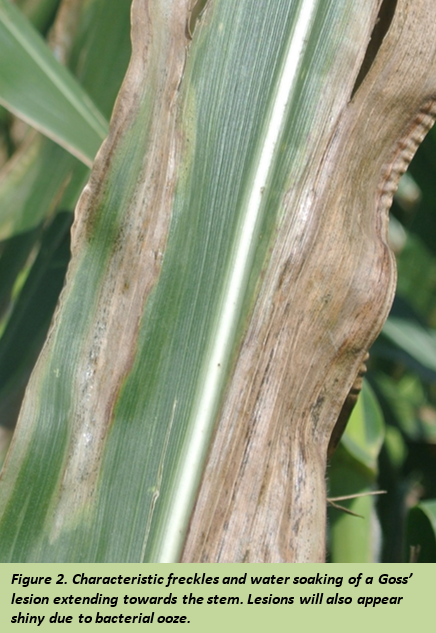Goss’s Leaf Blight and Wilt of Corn
Goss’s leaf blight and wilt (commonly referred to as ‘Goss’s wilt’) is a bacterial disease of corn that has been in the U.S. (Nebraska) since 1969, in ND (Emmons County) for about a decade, and in east-central ND for at least five years. We have observed the disease in Carrington REC corn trials. NDSU has conducted field surveys for the disease since 2014, and in 2017 found the disease in 35% of commercial fields surveyed. The disease will cause economic yield loss of corn in ND, with potential to reduce yield 30-50% in field areas where the disease is present.
The bacteria causing the disease can survive on corn residue for 10-14 months and is transported by water to corn plants. Disease infection primarily occurs after corn leaves are damaged by high wind, hail, etc. in combination with rainfall (or irrigation). Disease development in the plant is favorable with wet and warm weather (80 degrees is optimal temperature). The bacterial disease has two phases: 1) leaf blight and 2) systemic wilt. The leaf blight phase is most common and typically appears mid-season. Corn leaf symptoms and disease signs include irregular, water-soaked tan lesions that have ‘freckles’ and shiny patches (bacterial ‘ooze’). The picture shows typical leaf blight symptoms (courtesy of A. Friskop, NDSU Extension plant pathologist). Typically, areas along field edges or small spots within fields will show upper leaves turning brown and dying. However, a field near Carrington in 2016 had a high incidence of Goss’s wilt essentially throughout the entire corn field.

Typical leaf blight symptoms.
The most important management factor for minimizing potential yield loss from Goss’s wilt is use of tolerant corn hybrids. Crop rotation, not locating corn fields adjacent to previous year’s disease-infected corn field, and corn residue management will aid in reducing disease risk.
Greg Endres
Gregory.Endres@ndsu.edu
Area Extension Specialist, Agronomy


